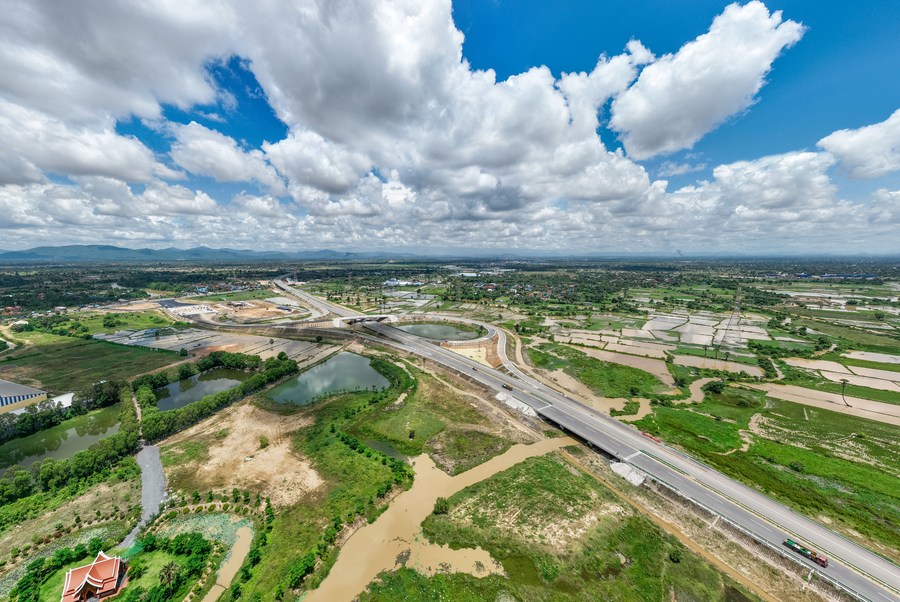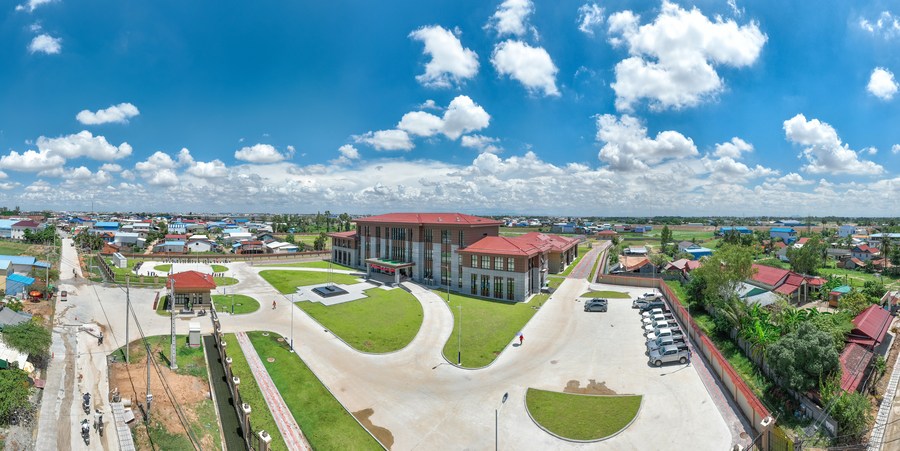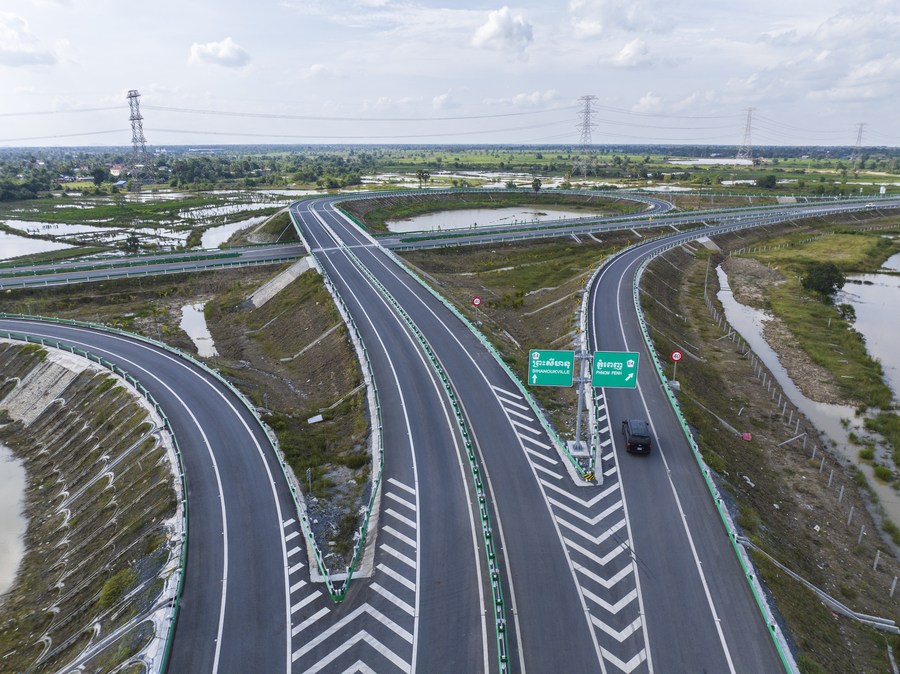One year on, RCEP, CCFTA give momentum to Cambodia's trade growth in post-pandemic era

Aerial photo taken on June 24, 2022, shows the Phnom Penh-Sihanoukville Expressway project in Kampong Speu Province, Cambodia.(Photo by Li Zhen/Xinhua)
The RCEP and the CCFTA, both took effect on Jan. 1, 2022, have injected a vital impetus to Cambodia's trade growth and helped Cambodia diversify its exports and further integrate into regional and global economy, said Cambodian officials and experts.
PHNOM PENH, Dec. 25 (Xinhua) -- One year on, the Regional Comprehensive Economic Partnership (RCEP) trade deal and the Cambodia-China Free Trade Agreement (CCFTA) have injected a vital impetus to Cambodia's trade growth in the post COVID-19 pandemic era, an official and experts said.
Cambodia's trade with RCEP member countries was valued at 24 billion U.S. dollars during the January-September period of 2022, up 11 percent year-on-year, while the kingdom's bilateral trade with China also increased in the past year, a government report showed.

Aerial photo taken on June 24, 2022, shows the operation center of the Phnom Penh-Sihanoukville Expressway project in Phnom Penh, Cambodia.(Photo by Li Zhen/Xinhua)
Cambodian Ministry of Commerce Undersecretary of State and Spokesman Penn Sovicheat said Cambodia's 2022 trade growth is moderate because the kingdom and other countries alike have just recovered from the COVID-19 crisis, but he believes that the growth will be higher in 2023 and beyond thanks to the RCEP and CCFTA deals.
"Both RCEP and the CCFTA are catalysts for our long-term and sustainable trade growth and the two trade pacts are a magnet to attract more foreign direct investments (FDIs) to our country," he told Xinhua. "More FDIs mean more new capital and more new job opportunities for our people."
Sovicheat said the two FTAs are quite beneficial to Cambodia as both have given the Southeast Asian country larger market access with preferential tariffs.
"For us, we stand to gain a lot from these FTAs because although Cambodia is a small country, we've already become a part of regional and global supply chains, we've already specialized in producing garment, shoes, travel goods, part components, and bicycles for export to the world," he said.

Garment workers make clothes at a factory in Phnom Penh, Cambodia on Dec. 17, 2021. (Xinhua/Wu Changwei)
"On top of these, our agricultural products, particularly milled rice, have already become well known in the markets of Europe, the U.S., and China, among others," he added.
The spokesman said the two pacts have also helped Cambodia diversify its exports and further integrate into regional and global economy.
"Both trade pacts could help Cambodia graduate from its least developed country status, likely by 2028 and achieve its goals of becoming an upper-middle income country in 2030 and a high-income nation by 2050," he said.
Thong Mengdavid, a research fellow at the Phnom Penh-based Asian Vision Institute, agreed that both trade deals are key contributors to boosting Cambodia's economic growth and international trade in the post-pandemic era.
"Both FTAs have also boosted the development of the fledgling e-commerce industry in Cambodia during the peak of COVID-19 pandemic," he told Xinhua.
Mengdavid said the increasing trade volume between Cambodia and China is a result of good relations, commitment and the same aspiration for building a "community with a shared future" between the two countries.
He added that RCEP has allowed its members to conduct trade, investment and mobilization of resources and materials in freer and friendlier methods and with less restriction, promoting productivity, economic resilience, and regional economic recovery.

This aerial photo taken on Oct. 28, 2022, shows the Phnom Penh-Sihanoukville (PPSHV) Expressway in Kampong Speu Province, Cambodia.(PPSHV Expressway/Handout via Xinhua)
"Thanks to China's vaccines and its leading role in combating the COVID-19 pandemic, the regional economy and activities are recovering back to the pre-pandemic era while also encouraging more investment on technologies, e-commerce and e-financing, agriculture, green energy and infrastructure development," he said.
Joseph Matthews, a senior professor at the BELTEI International University in Phnom Penh, said RCEP, the world's largest trading bloc, has been giving a big boost to regional and global economic recovery in the post-pandemic era.
"This agreement holds huge potential for all participating countries to boost their trade and investment and to quicken their economic recovery from the COVID-19 pandemic," he told Xinhua.
"Under the RCEP deal, all member countries will reap long-term benefits by integrating further into regional and global supply chains and creating new jobs for their respective peoples," he added.
Both RCEP and the CCFTA took effect Jan. 1, 2022.
RCEP members comprise 15 Asia-Pacific countries including 10 ASEAN (the Association of Southeast Asian Nations) states, namely, Brunei, Cambodia, Indonesia, Laos, Malaysia, Myanmar, the Philippines, Singapore, Thailand and Vietnam, and their five trading partners -- China, Japan, South Korea, Australia and New Zealand.


